American Sabbatical 55: 11/23/96
Anza Boreggo
At this point the narrative diverges for a couple of days. Bryce
went off into the desert with his buddy, John. Peggy stayed in
San Diego and went to school with John and Alyce's daughter, Hannah.
11/23-24.. Anza Borrego.
John and I spiraled our way out through the southeast quadrants
of San Diego on a lukewarm morning in his 71 VW camper bus. Gas,
water, air, ice, groceries and a feeding frenzy at Trader Joe’s.
This is California’s discount chainstore of upscale munchies.
Dried fruit, nuts, juices, beers, packaged salads, cheese, wine.
Pine nuts and blackcurrant tea. Kind of a whole-food Marden’s.
Grocery shopping with the locals in a crossroads burg means everything
from cheap milk and eggs at the local liquor store, through chain-market
sundries, to bare-bin merchandising for forklift staples. Fresh
fruits and veggies from Maria’s, where the naked produce is just
off the tree. Fit for a prince, but priced for a pauper. And everyone
is scuttling from lot to lot under low gathering cumulus and a
steamy sun. Faces from a thousand places, every shade and jut
of cheekbone, dialect and eyeslant, intricately painted fingernails
and cowboy hats, shaved-heads and cornrows.. and everyone with
a nod and smile and a ‘scuse me, eyelaughter with the kids and
banter with the clerks. Today the race war is in truce in Encanto
and LaMesa. We make our last circle under a 6-way overpass sculpture,
the purest form-follows-function in concrete curve, clattered
up the ramp onto the interstate, jacked American Beauty Rose into
the stereo, and put some dust behind us.
Looking back into the smutchy city as we rollercoast through Encanto,
then up at the conical hills engulfed in house plotches, we follow
the outbound traffic as it weaves between the residential heights
of LaMesa around Mt. Miquel (crowned in radio towers), and Mt.
Helix (with a cross). The highway descends into ElCajon.. the
box.. a canyon known for its breathless swelter in dry times.
Today it’s full of sunshowers and tile roofs and suburban traffic.
The vegetation is still a dooryard botanist’s bonanza, all grown
out to its full feather where irrigated. The roads merge and rise,
and Route 8 goes “over the mountain.” Successive zones of aridity
arise alongside as the clouds thin: scrub chaparral slopes, pastoral
black oak parks in watered valleys with cattle grazing the khaki
grasses, pines on the moister heights, sycamores and cottonwoods
in narrow bottomlands with ever dryer uplands as we climb. The
highway swings southeast, converging with the Mexican border.
Straight ahead is a grand conical mountain, Mt. Laguna, and the
country hardens, bristles more, shows some bones. The sun has
an edge.
The gullies are dense thickets of evergreen and there is enough
cover for a party of men to trek a weary way through, to a maybe
highway pickup. Border Patrol wagons, Bronco and vans, green on
white, are frequent, as are the stopped vehicles. There are always
shouldered autos steaming on the big mountain crossings, but there
seem to be more beat vans than average here. As the road tops
out at 4000 feet, the scale of things expands. Looking south you
suddenly see range beyond jagged range fading into purple. The
cordilleras of Baja. Mountains of Mexico. And the naked granites
heave themselves into bold outcrops.
On the sunrise crest of this east-rolling wave is perched a 4-story
fieldstone tower with top windows all around, and a parasol roof
of tin. A roadside attraction, and John insists we cough up the
$2 to view the sights. Here’s a crank’s vision: a junky “antiques”
selection in the now scorched and faded frame building whose back
room is the tower. The circular stair hugging the outside wall
opens into a room at each story level, and each room has a decor
theme. One is all framed lithograph illustrations of great battles,
mostly Civil War. There are a few dusty military jackets and a
military saber. At another height there are Indian mythafacts,
a head-dress or two. The whole place could be late forties. (They
once had Rommel’s binoculars mounted to a stand, but they were
stolen.) At the top there’s a wraparound breath-taker. Between
ranges of descending mountains you see out onto the basin floor,
dazzling desert for thirty miles, then the green patchwork of
industrial cropland, the Imperial Valley, but seen from so high
and so far that it is merely a thin greenish patterning in the
heat-haze.. and beyond that the dark blue puddle of the Salton
Sea, edge on. Faint blue mountains on the horizon beyond.
Up here on the brow, the mountains are immense piles of gigantic
boulders. Boulders the size of houses, busses, freightcars, down
to mere VWs and Yugos, all weather-rounded smooth and heaped any
whichaway. One of which boulder-stacks is directly below the tower,
and from this high vantage you can see large animals carved in
the rocks, and slightly painted. A six-foot lizard crawls down
a granite curve. So we coil downstairs through the “historic”
brickabrack and flap our feet into the foots-on portion of the
“Desert View Museum”. A hide-and-seek jumble of stoop-unders,
scramble-arounds, and clamber-overs, illustrated with amusing
foundling critters or other projected images. An Indian head in
full feather, carved and outlined in red, transforms a triangular
fragment six feet across into a surprise encounter when you look
back down onto it, and a monstrous stone face bares his whitened
teeth at you around the next twist. Snakes and toads, partibeasts
and hippogriphics, all conjured by this roadside visionary. (If
you were dreaming about a desert retirement business, the whole
museum is for sale.)
Then it was a freewheeling gallop down onto the desert bottom,
canyons opening on either side, finger ridges of tumbling boulder-mountains
spilling onto the floor. The In-ko-pah Mountains we’ve just highballed
down are yellow-white eroded granites clothed in barrel cacti
and cholla, creosote bush and agavi, all the spiny greens and
desiccated gray shrub-skeletons of a thirsty, even-spaced economy.
Away across the flats to the northeast the hulking Chocolate Mountains
run across the picture like a folded fabric of purple-brown. This
is where we get off the main drag. Ocatillo. And cut back north
and west into the Anza Borrego Desert State Park, off the hot-top
and into shimmering granite sands, and dust.
Capitan Juan Bautista de Anza led an emigrant party from lower
Mexico to Monterey through these canyons in 1775 and the Butterfield
Overland Mail coaches struggled up devilish mountain trails through
here. Sections of the stage route are still visible, clinging
to the landscape, and bits of old Rt80 have left cement arcs shelving
here and there. Travelers have always been glad to put this nightmare
behind them, but we are headed down into it for a night’s dreaming.
John has been uulating with abandon as we descend into the baked
air, and he joyrides the van like a jetski across the winding
sand-track. We jostle and jitter across the rock outcrops. Dead
singing: Casey Jones you better... This section is BLM land, where
anything goes, and we swing off into a turnout where the ground
is littered with shell casings and shattered glass. We poke around
in the debris and come up with a plastic artifact. An articulated
spaceman circa 1950’s, about 4 inches long. Like a piece of our
childhood, where we did horrible things to molded hydrocarbons.
We sit him ceremonially on the dash.
One big arroyo drains Palm Canyon and we drop into its dry bed,
roar across and up out again. The abandoned San Diego-Arizona
RR line crosses our path, rising along its embankment at a 2%
grade into a diminishing parallax, we surge over and spin-slide
into the loose sand beyond.
John has been organizing a “cave howl” out here every April for
a dozen years, where a wintercrazed band of friends come to empty
their lungs and make echoes in the rockpiles. We skid to a halt
in a plume of dust at the base of another megalith mass, Piedras
Grandes, where a series of underpile caves crawl and hunker back
into the mound. The cave howl hotel. The sun is inclining to late
afternoon but it still bakes the surly stiffness out of you, and
the silence sucks your noise. The surrounding desert is dotted
with jumping cholla, Mormon Tea, and OCATILLO. A new kind of astonishment.
Ocatillo is a spiny gray shrub which fans up like an umbrella-stand
full of wicked weapons. Each stem in the spreading cluster is
unbranched and more-or-less straight for up to 20 feet, terminating
in a (now withered) floration, and the waxy-gray stalks are thick
around as a broom-handle but as spiky as the nastiest cactus.
Altogether evil and admirable items, like skeletal tulip trees
with thornskins.
The Mormon Tea is an old friend, and the first desert plant to
speak to me. He was the stiff-fingered green things we met in
the sunset outside Kingman, a dead yellow clump of which we waved
at Coyote and planted as a hood ornament on the Owl. Subsequently
we discovered that he is Mormon Tea, the source of Ephedra, toymaker’s
choice of decongestant, sold in chemical facsimile as Sudafed
(pseudo-ephedra). It felt very clearheaded to be camped among
spreading clumps of the yellow-green magic.
As for Jumping Cholla it’s a segmented spiny cactus whose outer
sections snag passersby and are distributed by ouch and outcast.
Each segment will root and grow at will, and various desert animals,
like pack rats, jam their burrow entrances with these prickerballs
by way of welcome mats.
I broke out the drawing utensils while John distributed camp gear
around the environ, and we both unwound into lounge chairs as
shadows began to sidle out from the foot of the western hills.
John and I had some heavy baggage to unpack and we fenced around
the issues, between reminiscence and yodels, declared a truce
to compose a camp feast, and silently watched the pinks and purples
fade, and dark blues deepen.
But not too deep. The desert was strangely iridescent and the
stars but faint. Then the full moon slid out from behind Piedras
Grandes and we howled in delight. A setting planet (Venus?) hung
in a cleft of the In-Ko-Pah, and a mountain breeze flowed coolly
down the valley. We added layers, but the air on our faces was
still in the 60’s, and our nighteyes opened to the clumped angularities
of a darkened desert. It seemed like a good time for a cleansing
ritual.
We built a circular pyre out of a tin can and fire-starter sticks,
stuffed the toy spaceman with match-heads and sat him on top,
squirted charcoal starter fluid over and around the altar, and
tossed a lit match at it. Poof. Ah the childhood smell of burning
plastic, transporting us to the back lots of suburban New Jersey
in the 1950’s. We said a few words, and successfully immolated
THE PLASTIC INNER CHILD. Whew. The only thing better would have
been to do wheelies all over the moonscape on a four-wheeler.
After the holy fire died down, we went for a hike up-canyon in
the polarized unreality. I was bearing a wand of dead ocatillo
to ward off the strangeness, but it was a futile gesture. This
alien place with its coarse crunchy footsteps and skeletal wraiths
sneaks up on you. In the lees of the big rocks their absorbed
heat bathed us, and as we returned downwind the descending air
became still and a new, warm draft flowed up out of the Imperial
Valley. We put down our baggage, only partially opened, and sighed
into our beds.
We both were awake by moonset and watched another planet settle
into the mountain notch (Jupiter?). The In-Ko-Pahs were dusted
with a faint yellow-ruddiness, while all the reds seeped in succession
into the indigo over the Salton Sea. False dawn in absolute stillness,
and I’m disoriented by memories. This is the oceanlight on North
Atlantic fishing grounds, running out before dawn, but there’s
no salt in the air, just a prickling dryness. And then the sun
balloons up and bristles against your face.
We concocted an exotic breakfast as the sun shucked us out of
our layers, and we batted half-truths back and forth, looking
for an opening. Old friendships separated by miles and years are
tenuous mutualities. You are constantly sinking into comfortable
familiarity only to be shocked by present realities. You don’t
want to wound memory, but the honesty of friendship can cut like
a knife. I find that I can’t say all I want out here in the big
empty, and John keeps his guard up. For all that there is a good
feeling that the thread still connects, and lots of laughter at
retold foibles. The bragging of fools.
John has a list of things to show me, and we straggle into a trek
across the canyon, out of an extended walking conversation. Where
the cholla and ocatillo and agave and ephedra slope down into
the dry arroyo there are pottery shards among the rocky flints
and fragments. Eighth-inch to quarter-inch thick segments of reddish
brown clay, as simple and unadorned as the eroded boulders piled
around us. Combined with the mortar-holes ground into Pietras
Grandes, these scatterings of an ancient people suggest that this
was once a more watered place, with scrub oak worth camping by.
We climb up among the boulder heaps and follow a drywash choked
in wait-a-minute bush, dwarf mesquite, and the rubble of millennia,
climbing into a wider prospect and a gasping sweat. At one point
John says turn around and points at a granite boulder. There in
the coarse-textured white-orange is a petroglyph incised a good
half inch into the stone, whose meaning is almost apparent these
ages later. At the top is a horizontal line maybe 8 inches across.
Six inches beneath it is a zigzag of three joined strokes, looking
like two mountains: a single downstroke from the right, rising
to a peak on the left, then down again. Beneath this is what might
be a bird’s footprint: a single vertical stroke with a V superimposed
halfway up. The straight line runs directly for the “mountain
gap.” In the lower righthand quadrant formed by this Y-form is
a single deep dot. Standing where we are, looking down the wash,
the petroglyph is on a boulder in our right foreground and we
are looking onto a tripart fork in the road between mountain slopes
with the Salton Sea in the heat-hazed distance. Was this an old
road sign? If so, the California tradition of obscure signage
has a greater claim on antiquity than I imagined, and I will look
on all future frustrations as the result of Indian tradition.
More of that morphic resonance.
We turned back to our climb, scooching up over grand megaliths,
winding around giant tumbles, climbing to the sun. But the central
cleft begins to show increasing signs of moisture, more luxuriant
desert shrubs, more succulent effusion in the crevasses. Then
we scramble over a sundazzled crest and come face-to-face with
a big fan-palm tree, whose trunk is covered down to the ground
with dead fronds, so the whole looks like a hula-dancer with a
head-dress of yellow-green fans. Up another level and we are confronted
with an entire grove of these Native California Palms, wedged
together in the seeping rock, and making caves of coolness in
this high sizzling spot. The palms rise up to 60 feet and the
grove is maybe 150 feet in diameter. A mountain desert oasis:
the Morro Palms. Butterflies flitter in and out of the shade and
John stirs a lizard, which I don’t see. In fact all the sighted
lizards on this trip have dodged me. Something won’t reveal itself
to me in a desert place.
We drink the water I’m lugging, tell a few lies, and than ease
the old bones down the boulderwash and back onto the sandy flats.
The sun is declining again, and we promised to be back in San
Diego before dark, so we hoof back to the van, pack up without
dawdle, and spin tires toward the hot-top. Doing the sand-slalom
boogie out of this magic place our eased spirits rock-and-roll
to one of Jerry’s tunes.
We pitstop at a convenience mart-take out in Ocatillo, and the
lot is filled with campers pulling trailers, filled with 4-wheelers.
There is a big hi-tech balloon-tired Baja racer riding high on
immense shocks: a cactus eater. The whole race crew is along in
Broncos and Winnebago. Everyone has that sun-burned Sunday look,
and my eyes are smarting, my nose is dusty-dry. We make the long
trucklane climb over the mountain, catching glimpses of Pietras
Grandes in Palm Canyon behind us through the rising bounder masses.
Then we’re gazing down into Mexico again, and the Border Patrol
wagons are pulled on the verges here and there.
Now that they’ve put a plug in the Tijuana crossing more emigres
are creeping through the mountain chaparral, and Uncle’s finest
are hot-rodding around in pursuit along Rt8. It looks like overkill,
until you figure the numbers. We saw two illegals being held on
a scrubby slope in our brief passage. Clean cut men in crisp new
clothes. How many more were out there in the terrain? It doesn’t
make me feel real good about America, though, this hide-and-seeking
immigration.
There were more valleys full of strange trees sipping at hidden
watercourses than I remembered, and each lushening of the vegetation
made a little leafing-out in me. Desert may be good for the soul,
but the heart loves a tree. Cresting La Mesa, the big red ball
was just touching water beyond the shipyard giraffes, and the
lurid colors of a San Diego sunset swallowed us.
(Memo #48)
Nov. 26 - Encanto Elementary School
Who? children of Encanto elementary 6th Grade
What? class visit
Where? eastern suburb of San Diego
When? today
How? daughter of a friend is in class and invited me
Topics: public education, tracking
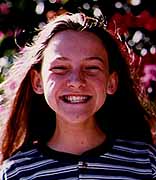
Tour Guide
One of my hopes for my sabbatical has been to work with students
in Freeport by e-mail and face-to-face in the areas I visit. Today
I got a chance to meet a sixth grade at Encanto Elementary School.
Encanto is a residential section of San Diego on the east edge
of the city and Hannah, the daughter of Bryce’s friend from 3rd
grade, is a student there. I offered to speak to her class and
got an enthusiastic invitation from her teacher.
It is a huge school of approximately 1500 students. The buildings
show that we are in California: Spanish style architecture of
buff colored single story buildings with classrooms that have
doors to the outside and long verandas. The school yard is bare.
As we drove up the school, the security squad was on duty (six
students, 2 with stop signs and four with flags). Traffic is halted
by flags lowered to waist level from the curbside and signs held
by guards who go out on the street. They sound whistles and stop
traffic so that students can cross. The students were milling
around the grounds in front of the school as they are not allowed
to enter until just before school begins. I went to the main office
with Hannah and signed in and got a visitors’ tag and some school
literature. The office was spacious and two secretaries were busy
with parents and students and phones. The school literature is
in both Spanish and English.
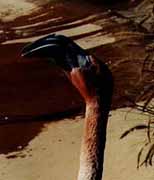
Ethnic Observer
Encanto has a multiethnic student body with faces showing Anglo
and Hispanic and Afro-American and First People/Native American
influence. The school serves the area of Encanto which is a working
and middle class neighborhood of single family homes lining small
streets through hills and canyons in eastern San Diego. Most houses
are Spanish style, single story on small lots. There are open
grassy hillsides and empty lots and some farm animals. After finishing
Encanto Elementary, students can choose the middle school they
wish to attend. San Diego has some magnet schools at the high
school level with subject specialties (art schools, math/science
schools). I saw an intriguing official building right in downtown
San Diego that was a “school of the streets” and am eager to learn
more about it.
Hannah’s classroom is a “seminar” class, i.e. a high ability group
that is selected for this class. There are eighteen students in
Ms. Candage’s self-contained sixth grade. The room is big and
bright and crammed with materials. The desks are organized into
three- or four-student pods in the center of the room with materials
on them. There are tables and work areas and bookcases and files
and bulletin boards. Many posters decorate the wall - Great Afro-Americans,
Great Hispanic-Americans, Great American Women. Recent student
projects are posted. There was a chart of a plot plan with parts
labeled (i.e. denouement) .The daily schedule is on the board
as well as the list of assigned jobs for the class (a long list
that includes Librarian, Attendance Taker, Distributor of materials,
Check Off Person, Points Person, Calendar Person etcetera). Jobs
change each week. Hannah explained the points system (Ms. Candage
gives points for extra or exemplary work and deducts points for
bad behavior or missing work) which is entered into an individual
checkbook. A students does the math in his/her checkbook and may
get prizes (books) at the end of the semester depending on their
“savings”.
The class has been studying early American history and immigration.
A large chart on one chalkboard listed the different groups that
make up our population, where they originated, why they immigrated,
where they settled, how they were treated, how they survived and
what contributions they have made. The answers were quite extensive.
Asian-Americans and Mexican-Americans were among the groups listed.
A few minutes before the school day began, the students entered
in a mass. Ms. Candage met them at the door. In an orderly fashion
they stowed coats and lunchboxes, got out books and homework and
went about their assigned tasks. The Librarian, for example, checked
books in to the class library and stamped other books out. The
bell sounded and the class recited the pledge and sang "America
The Beautiful". Ms. Candage made some announcements about the
day and the upcoming Thanksgiving holiday.The eighteen students
show tremendous diversity. There is a Japanese exchange student
and several fairly new immigrants. A polychrome group for sure.
She then introduced Hannah who introduced me. I sat in a high
deck chair at one side. I told the students what a sabbatical
is, showed the map of our travels to date, described a few places
we’d been and animals and sites we’d seen. I asked for questions.
I got a slew . Every question lead to another. In our interchanges
it became clear that these kids knew a lot - what the BIA was
and when it was established, what the Trail of Tears was and where
it had gone, who Sequoia was and what he invented, where the redwoods
are(!!!). I was impressed by their courtesy and attention and
by their solid foundation of knowledge. I divided my souvenir
postcards into bunches for each desk area and let the kids look
through them and ask more questions. Several girls wanted to know
more about Hearst Castle, several others asked about artists of
the reproduction postcards. I also discovered that many student
had traveled, especially throughout California and the southwest.
Encanto Elementary does not yet have an e-mail or Internet connections
but will by next year. About half the students have computers
at home and about a third had e-mail, so I put my e-mail address
on the boards and asked each student with a computer to get a
class buddy to share access with, and to keep in touch with me
. I really hope they do. I t was great to be back in a school,
but also exhausting. The eighty minutes flew by.
(Memo #49)
Nov. 27 - Sea World
Who? teams of animals trainers, vets, biologists, visitors
What? animal sanctuary, display, performance theaters, menagerie
Where? huge park with indoor and outdoor displays
When ? last thirty years
How? private business with high entrance fees
Topics: zoos and other animal displays, human-animal relationships,
the architecture of menageries.
Questions: How can humans be brought into contact with the natural
world in the best way for animals and people?
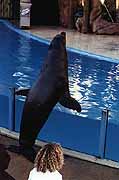
Sea lion strut
The day before Thanksgiving, Hannah and I set off for Sea World.
I have become ambivalent about zoos and aquaria and wanted to
see animals in another context. I went to the Monterey Aquarium
in early November and found it fascinating. Many of its displays
were open to the sea. Only in one or two tanks did the animals
seem crowded. I had concerns about the seashore exhibit that enclosed
fish and birds in a small wirecrowned area. The Central Park zoo
I toured as a child was small and cramped and the animals had
looked mangy and miserable. At San Simeon/Hearst Castle we saw
the small concrete pits where William Randolph Hearst kept his
polar bears. At Yellowstone we saw animals in a “natural” setting
that seemed as contrived and contained as a zoo. We had gone to
the famous San Diego Zoo in 1986. I had been impressed by the
larger cages and open areas, but the big cats still paced with
restless energy and I found the primates especially unnerving,
as the beings in cages seemed a bit too much like us. We decided
not to revisit the zoo this visit even though it now has koalas
and pandas, but I had seen photographs of the shows at Sea World
and was intrigued. Was Sea World a good place for animals? Was
it like a zoo? How were the animals trained? What was the relationship
like between animals and trainers? Is there a really good way
that animals can be kept in captivity without being stressed?
Should animals be put in shows to perform tricks?
Sea World has its own exit off the freeway in San Diego. It occupies
a large site in the big city park on Mission Bay. I was put off
by the $5 parking fee, but we were early enough to get a front
row place. Everything about Sea World in San Diego (and I suspect
its counterparts elsewhere) shows careful planning and construction.
It is clean and bright and colorfully decorated and beautifully
landscaped. I was as impressed by the plantings as by the exhibits.
Wide concrete paths wind between huge palms and birds of paradise.
Copses share sites with sea creatures and every lawn and “island”
has beautiful flowers. The lush greenery is impressive. Staffers
in uniform are everywhere and there is constant maintenance underway
(sweeping up every bit of paper as it drops, it seemed). The exhibits
are spaced out over a huge area with restaurants and giftshops
and planted areas scattered throughout. In the center is a space
needle that had an elevator. One sign of the cleanliness of the
whole place was the lack of smells except for a faint aroma of
fish around feeding time.
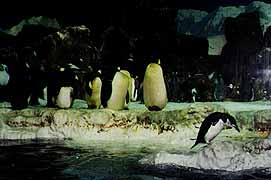
Penguins
The entry fee is high, but gets you a full day and you need a
full day to see everything. There are set times for shows and
feeding times, but also indoor and outdoor exhibits and rides.
We checked our schedule and decided to tour for an hour before
the dolphin show. We went to the shark exhibit where you first
see them in a tank swimming past the huge glass windows and then
a conveyor belt takes you through a glass tunnel with the giants
swimming right over and beside you (eerie!). The penguin exhibit
is a huge indoor tank (for cooler temperatures) and represents
an Antarctic landscape with ice areas and water. We could see
the animals swim and walk and interact. Outside again there is
a full flamingo flock (heaven for someone who is a lawn ornament
devotee) in an area with a pond, and a rock-edged sea lion pool
(which did seem small).
One amazing ride simulated a descent to the Atlantic’s great trench.
You enter a building and are prepared for your trip in the research
diving chamber. You then enter a small chamber (25 feet square?)
and sit in rows. You are strapped in. Screens around the walls
show you the outside “view” as you descend. Fish swim by and you
seen the ocean floor and a famous wreck. There are amazing lights
and switches to simulate a vessel and a running commentary by
a voice through a loudspeaker. The whole chamber lifts and rocks
and bumps as you “descend” to a wreck, have small accidents, finally
get clear. A particularly realistic touch was a fine water spray
that hit us after an accident’s bump. I was glad to get out.
Our first show was the dolphins. It was in one of Sea World’s
huge outside amphitheaters. Banks of concrete seats rose far above
the platforms beyond that. We chose to sit just above the six
rows of seats marked SOAK ZONE (no joke). Several young men and
women in wet suits were stowing things in boxes around the pool.
The M.C. sang songs, warned us about the soak zone again and introduced
the stars. The dolphins! For the next half hour we were mesmerized
as the animals performed to a wide array of signals from their
trainers. A wide sweep of the arm sent them to one end of the
pool or another. They would leap and turn over in the air, jump
high ropes, leap onto platforms and stay there posed. One dolphin
held herself up out of the water and seemed to hop across the
pool on her tail. Then a young woman keeper simply dove into the
pool and the animal-person performance began. The dolphins pushed
humans around the pool at high speeds, rode them on their backs
and jumped straight up with the human standing upright on their
heads so that a single human-dolphin column rose high into the
air before the figures separated and the two dove gracefully back
into the pool. After each trick the keeper patted and hugged the
animal and gave him/her fish. There was running commentary on
the animals - each is known by name, the M.C. tells you about
the species as well as the individual animals (age, gender, training,
health). The regular rushes and jumps of the dolphins sent water
over the tank edge, but they also have been taught to splash on
signal. They set themselves against the tank wall near the audience
and “scoop” water out in huge arcs with their tails, and the soak
zone gets soaked.
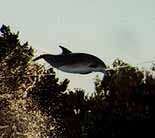
Dolphin Act
How do you determine an animal’s mental or emotional state? You
can do it with your own pets. Our dogs eloquently express excitement,
anger, irritation, hunger, affection. I saw a lot of affection
between the dolphins and keepers and the animals seemed to be
having a ball! In three shows we only saw one killer whale balk
at a trick. Otherwise they swam and leaped and - it seemed - cavorted
with glee. The m.c.s sounded upbeat and enthusiastic as they talked
about the performers, always as individuals by name. The training
programs have been refined through several decades and Sea World
is obviously proud of its accomplishments. I spoke for a few minutes
to a trainer who said it takes a long time to get to know the
animals. There is a team involved with each animal so that no
one person is tied exclusively to one animal. He said they develop
very close relationships with the animals.
Later we went to the huge area that is home to Shamu and the other
killer whales. There are large pools (sixty feet across maybe?)
where the animals can be seen between shows from the pool edge
or an underground observation window. The black and white killer
whales are simply beautiful. Their whole performance area is bigger
and glitzier than the dolphins’. There are three huge holding
tanks. A screen behind the “stage” has instant replay. Before
the show the screen posts questions, the audience holds up fingers
to answer and a camera captures audience members. The show was
as amazing as the dolphins’. These animals are so much bigger
! They seemed more contained by the pool. They jumped and flipped
and splashed and posed on command and rode their keepers around.
And a bigger soak zone got soaked (us included, but we dried off
within an hour in the San Diego sun).
One outdoor pool holds rescued animals that have been brought
to Sea World injured or sick. Small concession stands sell sardines.
We got to feed seals from a distance. Then we had the incredible
thrill of handfeeding dolphins. They came to within two feet and
took the fish from us. Their skin is slippery and rubbery. They
did not linger by us, but did not flinch or dart away from our
touch either.
In another outdoor pool rays flapped. Visitors were allowed to
touch them as they swam by. If they wanted, the rays could keep
out of touch distance. Again we got to stroke a number of them
as they glided by. One ray repeatedly swam by us near the pool
edge within touch distance and even splashed water at us, it was
repeated and intentional and only by us. An incredible joy to
feel a link to another species.
Our last show had a plot, marooned explorers on a desert island.
Basically the “story” simply allowed the animals to perform tricks
as the two young women explorers spoke their lines. The animals
were a sea lion, a huge walrus AND a sea otter. It was utterly
incredible to see the small otter pull strings and carry balls
and dart around the complicated set on command. And the 1500 pound
walrus roared and swam and splashed the audience on command.
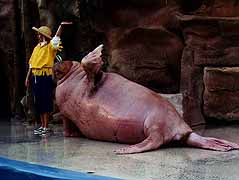
Walrus Wave
It was a long, full, exciting day. I’m not sure my questions about animals in captivity got answered. Sea World is a better place for animals than any other I’ve seen. They are treated with affection and dignity and individuality. Science is reaping benefits from the work. I would love to be a trainer and dance with dolphins. And yet whose needs are being served - the animals are still performing for humans on command. Would the animals all be better off in the wild? How much “wild” ocean still exists? An unemphasized point is that Sea World will teach thousands of people to respect the creatures of the sea. Perhaps visitors to Sea World will be less likely to injure animals or pollute.